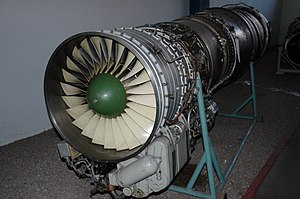Tumansky R-11
| R-11 | |
|---|---|

| |
| Preserved Tumansky R-11 turbojet engine at the Polish Aviation Museum | |
| Type | Turbojet |
| Manufacturer | Tumansky |
| First run | 1956 |
| Major applications | Sukhoi Su-15 Mikoyan-Gurevich MiG-21 |
| Number built | 20,900 |
The Tumansky R-11 (initially AM-11) was a Soviet Cold War-era turbojet engine.
Design and development[]
The Tumansky R-11 was developed by A.A. Mikulin, Sergei Tumansky, and as a twin-spool axial-flow high-altitude non-afterburning turbojet for Yakovlev Yak-25RV reconnaissance aircraft. This engine was the first Soviet twin-spool turbojet. It was first run in early 1956[1] and was later employed in some variants of the Yakovlev Yak-26 and Yakovlev Yak-27, as well as the Yak-28.[2] The R-11's basic design was very successful and it was later developed into the Tumansky R-13 and Tumansky R-25 along with the experimental Tumansky R-21. A total of 20,900 R-11 engines were built.
Variants[]
- R-11V-300 - first production version, high-altitude, non-afterburning
- R-11F-300 (R-37F) - afterburning version, entered production in 1956, used on MiG-21F, P and U.
- R-11AF-300 - improved version for Yakovlev Yak-28B, L and U.
- R-11F2-300 - new compressor, afterburner and nozzle, used on MiG-21P, PF and FL.
- R-11AF2-300 - R-11F2-300 adapted for Yakovlev Yak-28I, R and P.
- R-11F2S-300 - upgraded version for MiG-21PFM, PFS, S, U and UM, and for Sukhoi Su-15, UT and UM.
- Shenyang WP-7, Chinese license built copies of the R-11
Specifications (R-11F2S-300)[]
General characteristics
- Type: Afterburning turbojet
- Length: 4,600 mm (181.1 in)
- Diameter: 906 mm (35.7 in)
- Dry weight: 1,124 kg (2,477 lb)
Components
- Compressor: Axial compressor, 3-stage LP, 3-stage HP
- Turbine: one stage LP, one stage HP
Performance
- Maximum thrust:
- 38.7 kN (8,708 lbf) military power
- 60.6 kN (13,635 lbf) with afterburner
- Overall pressure ratio: 8.9:1
- Turbine inlet temperature: 955 °C (1,750 °F)
- Specific fuel consumption:
- 97 kg/(h·kN) (0.95 lb/(h·lbf)) at idle
- 242 kg/(h·kN) (2.37 lb/(h·lbf)) with afterburner
- Thrust-to-weight ratio: 3.51; 5.50 with afterburner.
See also[]
References[]
Citations[]
- ^ Gunston 1989, p.167.
- ^ Goebel, Greg. "The Yakovlev Yak-25 & Yak-28." AirVectors. Retrieved: 17 July 2012.
Sources[]
- Gunston, Bill. World Encyclopedia of Aero Engines. Cambridge, England. Patrick Stephens Limited, 1989. ISBN 1-85260-163-9.
External links[]
| Wikimedia Commons has media related to Tumansky R-11. |
Categories:
- Tumansky aircraft engines
- 1950s turbojet engines